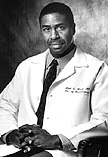Keith Black (surgeon) facts for kids
Quick facts for kids
Keith Black
|
|
|---|---|
 |
|
| Born | September 13, 1957 Tuskegee, Alabama, United States
|
| Education | University of Michigan Medical School |
| Known for | Brain tumor surgery and research |
| Medical career | |
| Profession | Neurosurgeon |
| Institutions |
|
Keith L. Black (born September 13, 1957) is a famous American neurosurgeon. He is known for treating brain tumors. Dr. Black also works to get more money for cancer research. He is the head of the neurosurgery department at Cedars-Sinai Medical Center in Los Angeles, California. He also directs the Maxine Dunitz Neurosurgical Institute there.
Contents
Early Life and Education
Growing Up in Alabama and Ohio
Keith Black was born in Tuskegee, Alabama. His mother, Lillian, was a teacher. His father, Robert, was a school principal. His father worked hard to improve the school for all students.
To find better schools, his family moved to Shaker Heights, Ohio. Keith went to Shaker Heights High School. He was already very interested in medicine.
Early Medical Discoveries
As a teenager, Keith joined a special program for students. He became a lab assistant at St. Luke's Hospital in Cleveland. He worked with inventors of an artificial heart valve.
When he was 17, he won a national science award. His research looked at how heart valve replacements could harm red blood cells.
University Studies
Dr. Black attended the University of Michigan. He was in a special program. This program let him earn both his first degree and his medical degree in just six years. He received his M.D. degree in 1981.
Career Highlights
Starting His Medical Journey
After finishing his training at the University of Michigan, Dr. Black moved. In 1987, he joined the UCLA Medical Center in Los Angeles. He later became the head of UCLA's Brain Tumor Program.
In 1997, he moved to Cedars-Sinai Medical Center. There, he became the director of the Maxine Dunitz Neurosurgical Institute. In 2006, he became the Chair of Neurosurgery at Cedars-Sinai.
Leading Brain Tumor Research
In 2007, Dr. Black became the director of a new research center. This was the Johnnie L. Cochran Jr. Brain Tumor Center at Cedars-Sinai. It was named after a famous lawyer who was Dr. Black's patient.
Dr. Black is often featured in the news. He shares new medical advances in brain surgery. He was on a PBS show called The New Explorers in 1996. Esquire magazine named him one of the "21 Most Important People of the 21st Century" in 1999.
A Busy Surgeon
Dr. Black is known for his very busy surgery schedule. A 2004 article in Discover magazine noted his work. It said he performed about 250 brain surgeries each year. By 2009, he had performed over 5,000 brain tumor operations.
In 1997, Time magazine featured Dr. Black on its cover. The article called him a "Hero of Medicine." It talked about his skill in operating on tumors that other doctors might not touch. It also mentioned his research on how a substance called bradykinin can help medicines reach the brain.
His Autobiography
In 2009, Dr. Black wrote a book about his life. It is called Brain Surgeon. The book shares his journey and experiences. It also talks about the challenges he faced to become a neurosurgeon.

